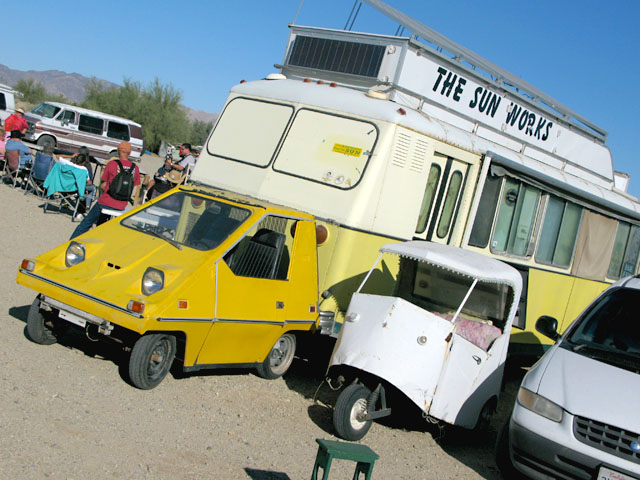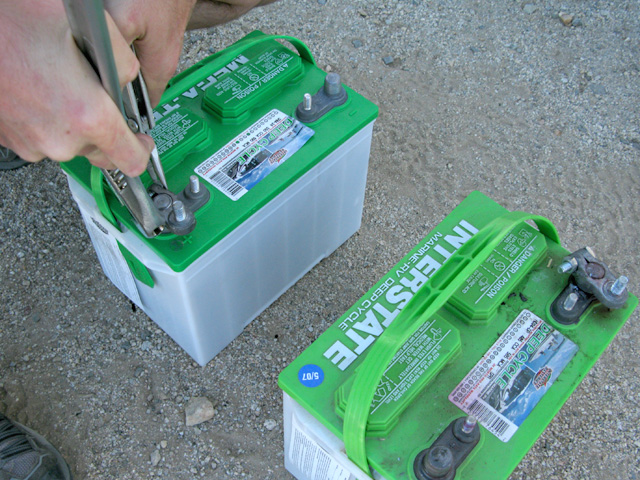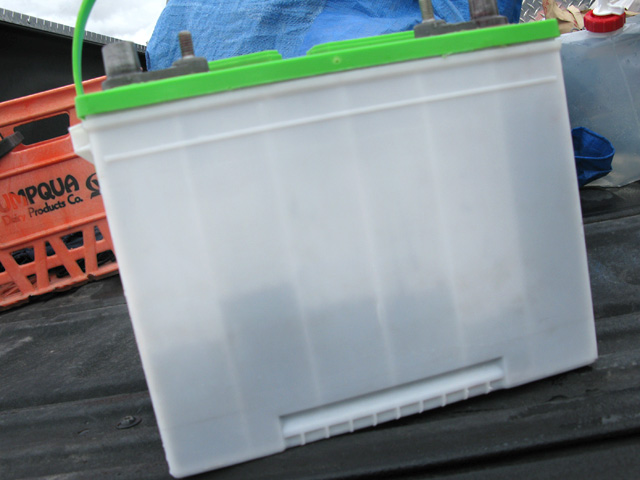 Ever since we got our rig, we’ve been fortunate to have a wealth of information at our displosal. I’m not talking about the obligatory gaggle of retired full-timers who gather any time you attempt to back up your rig. I’m referring to our rig’s solar power system.
Ever since we got our rig, we’ve been fortunate to have a wealth of information at our displosal. I’m not talking about the obligatory gaggle of retired full-timers who gather any time you attempt to back up your rig. I’m referring to our rig’s solar power system.
My brother in law Rich O’Connell is a brilliant electrical engineer. He has grown a successful solar business with my sister, built his own off-grid home, designed multi-gigawatt systems, and patented a solar panel washing system. He also designed the RV power system we rely on for boondocking.
Recently, I got to meet another expert; Solar Mike. He operates The Sun Works from his solar powered rigs on the slabs. Mike knows the DC side of the business and how to get the absolute most out of what you got.
 That’s why I was happy to be at Slab City when we considered upgrading our system. I had access to experts from extreme ends of the solar industry. Either one of them could have easily told me I had a bad battery. Which I would have known, and could have avoided, had I been servicing my batteries as they required.
That’s why I was happy to be at Slab City when we considered upgrading our system. I had access to experts from extreme ends of the solar industry. Either one of them could have easily told me I had a bad battery. Which I would have known, and could have avoided, had I been servicing my batteries as they required.
It just didn’t seem like we were getting the run time out of our batteries that we expected. Loving to boondock as much as we do, we explained our issue to Mike and asked him for an estimate for upgrading the system. He immediately discovered one of our batteries was weak, and pointed out how dry it was. Bone dry.
Yes, for you long time readers out there, we did learn this lesson before.
I might have kicked my feet and mumbled a bit, but – don’t tell Rene – I still think it was worth the $95 we spent on two new batteries to have not been pulling them out and checking them every month for the past year. Truth is, we just forgot.
 Yup, our upgrade cost us less than a hundred bucks. And it was so cheap because Mike took our good battery as a trade-in. The ones he carried were a bit better, and I wanted a matching pair. Not bad since we were considering spending over a grand on couple new panels.
Yup, our upgrade cost us less than a hundred bucks. And it was so cheap because Mike took our good battery as a trade-in. The ones he carried were a bit better, and I wanted a matching pair. Not bad since we were considering spending over a grand on couple new panels.
Had we spent the $4000+ on the original system design Rich gave us, we might have never even had this discussion. But having worked this over with Mike, I now know where in our 24′ trailer we can fit six maintenance free 6 volt batteries – much better suited for our use than the two 12 volts we have.
And having done it a couple times now, I know it’s not such a big deal to pull our batteries and check on them. We even carry some distilled water now so we have it when needed.
 I also know now that an MPPT charge controller is where we’ll invest our dollars the next time we complain about our system. That’s one thing Rich and Mike both agreed on – that any Maximum Point Power Tracking charge controller will boost performance performance of our PV array. Then we can start talking about boosting the battery bank and adding panels again.
I also know now that an MPPT charge controller is where we’ll invest our dollars the next time we complain about our system. That’s one thing Rich and Mike both agreed on – that any Maximum Point Power Tracking charge controller will boost performance performance of our PV array. Then we can start talking about boosting the battery bank and adding panels again.
When we will make that investment is the $3000 question. But that all depends on where we’re going to be purchasing property come Spring, and whether we will need to upgrade what we have or build a larger off-grid system in a shed or trailer. And we’re not even sure where we’ll be next month.
You might want to check that your charge controller isn’t overcharging the batteries. That’s a lot of water gone for a year of use. It’s hard for me to imagine that without overcharging. 2nd interstate batteries are junk now. Ever since a made in mexico sticker started showing up on them I’ve had very bad luck. Ones that used to last 5-10 years only last a year.
Thanks for the feedback Britt. It’s definitely not the controller, we just drained them to far way too many times our first year on the road without ever checking them. We are better battery parents now, paying closer attention to how we discharge them and checking them monthly.
I was talking with a salesman at a recent rv show about adding solar to EPDM roofing. Aside from a/c mounted units, he had no ideas for how to safely mount panels on the roof without the danger of leaks. Then it hit me! I mentioned that I had read about thin film solar and it’s use on EPDM roofs. Stick it down, run the wires, no penetrations, life is good. This guy like others I have talked to had no interest in mounting more than a panel or two. I have posed the question to solar dealers on the web with no positive results. What are your thoughts on this. Could it be a good alternative to rigid panels?
Thanks for you input.
Sure, once thin film photovoltaics are perfected they will make the ideal solution for RV systems. The technology is getting there, and eventually I’m sure we’ll be painting arrays an any flat surface, but we’re just not there yet in terms of power, durability, and cost. With proper planning to minimize mounting points and and big tube of Dicor roof sealant, leaks should not be a concern.